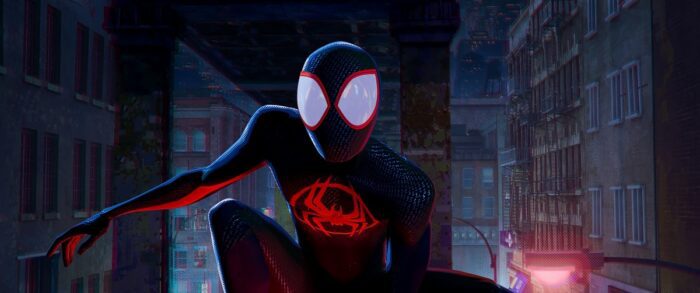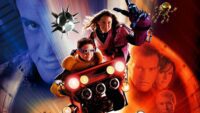In 2018, Spider-Man: Into the Spider-Verse reinvigorated the superhero and animated genres simultaneously. Its dazzling animation, fantastic soundtrack, and tremendous voice cast propelled it to become one of the best comic book movies, animated movies, and overall movies I have ever seen. Any follow-up to this movie—whether animated or a superhero movie—had big shoes to fill. And, quite honestly, nothing in either of those genres came close to the mastery of the eventual winner of the 2019 Academy Award for Best Animated Feature.
So, a direct sequel (specifically part one of a two-part arc) had an almost impossible task. How could you make something that reaches the highs of such an influential and unique predecessor? Moreover, since the first movie changed how we look at movies, how could a second part do the same and smash the glass ceiling even further? I am delighted to say Spider-Man: Across the Spider-Verse is an absolute triumph and accomplishes the impossible by going toe-to-toe with its previous installment.

Following the events of the first film, both Miles Morales (Shameik Moore) and Gwen Stacy (Hailee Steinfeld) seek connection to other Spider-people in their respective worlds. When a multiversal villain known as The Spot (Jason Schwartzman) has sworn revenge on Miles and threatens the entire multiverse, Miles finds himself in a battle alongside hundreds of other Spider-people from many universes and learns the actual value of being a Spider-Man.
This is, hands-down, the most stunning animated movie ever made. Yes, even better than the first one. The only way to describe the animation is kinetic—from the way it’s drawn to the way the characters and scenes move. Every frame has so much life and, similar to the first movie, it feels so much like a comic book. It’s ironic with the glut of comic book movies in the past 10-15 years, only Into the Spider-Verse and Across the Spider-Verse provide the cinematic experience of reading a comic book. But, it also is a testament to how truly great both of these movies are. This is what superhero movies should be, not Black Adam or Ant-Man and the Wasp: Quantumania.
The vibrant colors pop off the screen in a fashion that can only be described as erratic yet elegant. There’s a lot happening visually on every inch of the screen and it seems to be random. However, the animators and directors do a wonderful job of keeping it coherent rather than nonsensical. It’s an overwhelming experience, for sure, but in a good way. Like John Wick: Chapter 4 was overwhelming, the bravura filmmaking is done so well that one can’t help but be engulfed by the beautiful visuals and heartwarming narrative. There are certain shots that are so artistic and well-crafted, it’s like seeing a gorgeous hand-drawn painting. Animation has never been portrayed so expertly, but I feel this crew will somehow top themselves with Beyond the Spider-Verse.

In addition to the world-class visuals, the film’s story has a big heart and a strong emotional core. Many of the recent MCU entries revolve around the multiverse, but the issue is that these movies get so bogged down in the variant characters and fan service, they forget about giving their characters an arc the audience cares about. One reason why Everything Everywhere All At Once swept every award known to man was because it told a human story first, and then a multiverse story. Smartly, Across the Spider-Verse follows this model and is undoubtedly the best comic book movie about the multiverse, and perhaps the best overall multiverse movie.
Across the Spider-Verse never loses sight of the fact that the narrative revolves around Miles’ journey (and Gwen’s to a certain extent). He’s a 15-year-old kid who has to deal with the burden of being Spider-Man, and the sad reality that loss is a big part of every Spider-Man in every universe. This is where the multiverse comes in. There are a reported 280 Spider-people in this movie, and while some of them are there for fantastic cameos, a majority of them are there to relay to Miles about dealing with loss and accepting it. The writers use the multiverse to tell their emotional story, rather than making the multiverse their sole focus. Even if some viewers won’t get every reference or easter egg, they will never be lost in this movie.

The soundtrack is stellar as is Daniel Pemberton’s score, which propels the movie during its multiple staggering and impressive action set-pieces. Even at 140 minutes, Across the Spider-Verse never drags—I could have easily seen another hour of this frequently brilliant film and would have had no complaint. All the voice performances were great, but a special shoutout must be given to Oscar Isaac who gives so much depth and pain to Miguel O’Hara (and has the coolest suit out of any of the Spider-people).
What makes Across the Spider-Verse one of the best movies—not specifically animated or comic book—of the year is that everyone involved in the movie has so much love for the medium and Spider-Man. This is unabashedly a Spider-Man movie, which feels weird to say since it’s literally in the title. What I mean is that, unlike any other live-action or animated Spider-Man movie before it, this film celebrates the character through its many iterations but also the dark aspects as well. It embraces the fact that even through geographic, cultural, and physical differences, every Spider person is connected with each of their strengths and flaws.

This is an outstanding movie. Mind-blowing, jaw-dropping, whatever phrase or word you may use to describe this movie, it’s probably under-selling it. This movie and its predecessor warrant and reward multiple viewings to uncover all the hidden details and I can’t wait to revisit it. Is it better than the first one? Hard to say at the moment, but it’s right up there with it—which is an incredible achievement. The movie tells a complete story but also sets the stage for an epic third installment.
Into the Spider-Verse was revolutionary. Across the Spider-Verse is glorious. Beyond the Spider-Verse just might be earth-shattering.



